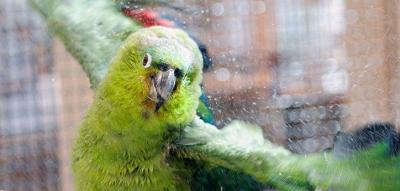
Pet Bird Baths and Humidity Levels
If you have pet birds, baths and proper humidity levels are key components to keeping them healthy. Most parrot species in the wild live in humid environments with frequent rainfall. Their respiratory system, skin, and feathers are designed for wet climates.
When pet birds aren't provided with this type of environment in captivity, they can overheat, develop inflammation in their respiratory system, develop painful skin conditions, and/or start plucking their feathers. Some birds will even mutilate their skin. Plus, several species of parrot, including cockatoos, cockatiels, and African grays, create a dust-like dander, which can be irritating for humans and other pets in the home if it's not managed through baths and humidity.
So how do you give a bird a bath, and what's a good humidity level for a pet bird? Here's what you need to know.
How to give a bird a bath
Regular baths or showers emulate the rainfall birds would experience in their natural habitat, and they are crucial for skin and feather health.
Home starts with you
One or two times per week is the minimum recommended amount for how often to give a bird a bath, but some birds need to bathe more frequently than that. Generally speaking, bathing once daily or every other day would be ideal for most birds.
There are several ways to bathe a bird:
- Providing an automatic misting system
- Spraying them with water (from above them) from a spray bottle on a mist setting, letting the water drift down to simulate a light rainfall
- Taking them into the shower
- Providing a shallow dish with warm water
For birds who aren't already accustomed to getting baths or showers, it is crucial that you don't force them to do so in a way that scares or angers them. Because baths are such an important part of birds’ lives, you don't want them to view bathing as something that's scary or dangerous. This is also why it's never acceptable to try to punish birds by spraying them with water.
The easiest approach is to offer each bathing method listed above one at a time and see whether your bird naturally gravitates toward one particular method. If your bird already enjoys bathing in a certain way, that makes your job much easier.
However, if your bird tries to avoid or escape every bathing method, you can pick one or two that work best for you and train your bird to accept — and eventually enjoy — bathing by using a training technique called systematic desensitization. The basic idea is to start with the closest thing to bathing that your bird does and reward the bird with something they really like every time you expose them to this limited version of bathing. Then, gradually increase the bathing behaviors through baby steps, making sure to keep each baby step pleasant and rewarding.
Humidity levels for pet birds
Unless you live in an area that is already naturally humid year-round, it is important to purchase a humidifier for every room in which your bird will live and play. It's best to use a humidifier that has a built-in hygrometer (the instrument that measures ambient humidity) and can be set to run at a specific humidity.
Molds start growing in the home environment at 60% humidity. Thus, a good humidity level for pet birds at which to set your humidifier is around 55%. This will ensure that your bird lives in as humid an environment as possible without mold growing. Of course, birds who spend time in outdoor aviaries can have higher humidity levels.
